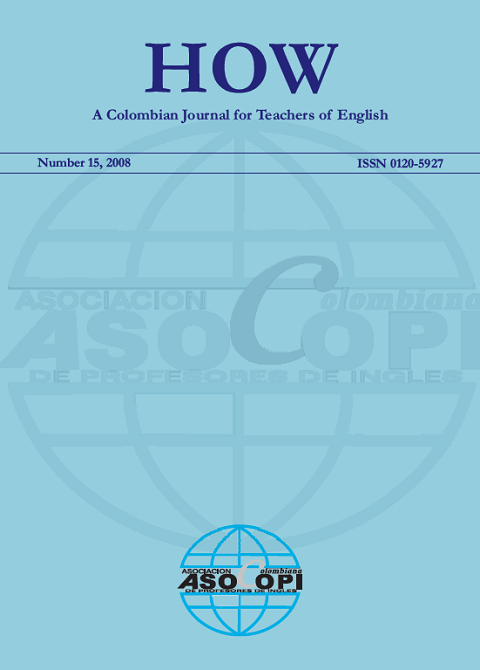El análisis conversacional en salones de clase de la escuela primaria
Contenido principal del artículo
Resumen
Detalles del artículo
Los contenidos de la revista HOW se publican bajo la licencia Creative Commons Atribución-NoComercial-SinDerivar 4.0 Internacional. Usted es libre para copiar y redistribuir el material en cualquier medio o formato siempre y cuando usted otorgue el crédito de manera apropiada. Usted no puede hacer uso del material con fines comerciales. Si usted mezcla, transforma o crea nuevo material a partir de esta obra, usted no podrá distribuir el material modificado. Más información: http://creativecommons.org/licenses/by-nc-nd/4.0/deed.es.
Se solicitará a los autores cuyos artículos se aceptan para publicación en HOW que firmen una cesión de derechos no exclusiva con el fin de permitir a ASOCOPI reproducir el texto completo en el internet o en cualquier otro medio disponible. Los autores conservan los derechos sobre sus manuscritos con las siguientes restricciones: el derecho de primera publicación es otorgado a ASOCOPI; los autores pueden establecer acuerdos no exclusivos con terceros siempre y cuando la publicación original en la revista HOW sea reconocida adecuadamente.
Citas
Bowles, H., & Seedhouse, P. (Eds.). (2007). Conversation analysis and language for specific purposes. Bern: Peter Lang.
Burns, A., & Moore, S. (2007). Conversation analysis and the accounting classroom: Exploring implications for LSP teaching. In H. Bowles & P. Seedhouse (Eds.), Conversation analysis and language for specific purposes. Bern: Peter Lang.
Cullen, R. (1998). Teacher talk and the classroom context. ELT Journal, 52 (3), 179-187.
Edwards, A. D., & Westgate, D. P. (1994). Investigating classroom talk. London: Falmer.
Hutchby, I., & Wooffitt, R. (1998). Conversation analysis: Principles, practices and applications. Cambridge: Polity.
Johnson, K. E. (1995). Understanding communication in second language classroom. Cambridge: Cambridge University Press.
Markee, N. (2005). The organization of off-task talk in second language classrooms. In K. Richards & P. Seedhouse (Eds.), Applying conversation analysis. Basingstoke: Palgrave Macmillan.
Pallotti, G. (2007). Conversation analysis: Methodology, machinery and application to specific settings. In H. Bowles & P. Seedhouse (Eds.), Conversation analysis and language for specific purposes. Bern: Peter Lang.
Psathas, G. (1995). Conversation analysis: The study of talk-in-interaction. Thousand Oaks: Sage Publications.
Seedhouse, P. (2004). The interactional architecture of the language classroom: A conversation analysis perspective. Malden, MA: Blackwell.
Seedhouse, P. (2005). Conversation analysis and language learning. Language Teaching, 38 (4), 165-187.
Seedhouse, P. (2008). Learning to talk the talk: Conversation analysis as a tool for induction of trainee teachers. In S. Garton & K. Richards (Eds.), Professional encounters in TESOL (pp. 42-57). Basingstoke: Palgrave Macmillan.
Tsui, A. (2001). Classroom interaction research. In R. Carter & D. Nunan (Eds.), TESOL Guide. Cambridge: Cambridge University Press.
Van Lier, L. (1988). What’s wrong with classroom talk? Prospect, 3 (3), 267-283.
Walsh, S. (2006). Investigating Classroom Discourse. Abingdon: Routledge.
Walsh, S., & O’Keeffe, A. (2007). Applying CA to a modes analysis of higher education spoken academic discourse. In H. Bowles & P. Seedhouse (Eds.), Conversation analysis and language for specific purposes. Bern: Peter Lang.

